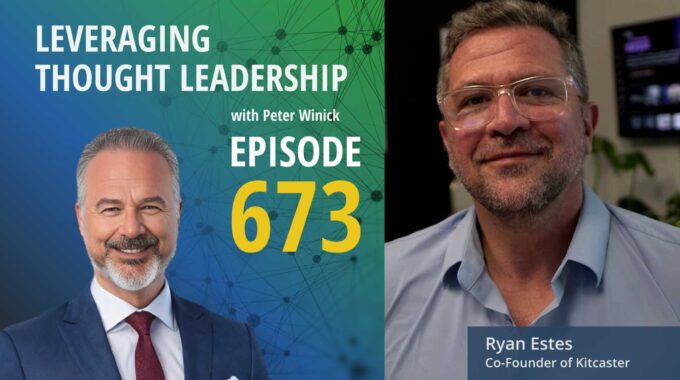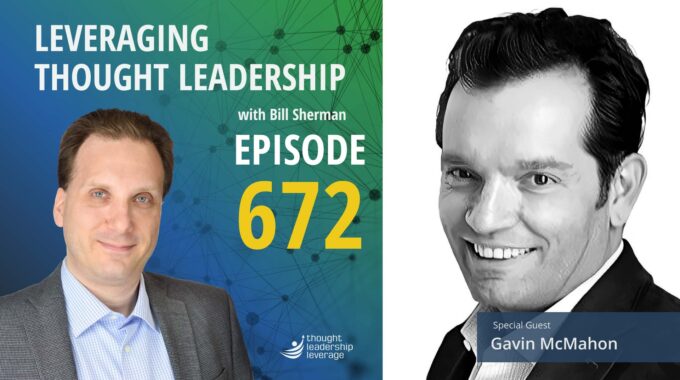Building Brand Love Through Storytelling This episode explores how storytelling can drive inclusion, purpose, and…
Evolution of Thought Leadership | Juliet Funt

Evolving Thought Leadership from post-it to page.
An interview with Juliet Funt about how she has evolved her thought leadership over the years as a keynote speaker and now an author.
Today we have the lovely Juliet Funt joining us! Juliet is a keynote speaker, and the CEO of White Space at Work. White Space at Work for the last decade has helped businesses gain back thousands of hours of lost productivity by helping employees find more time to pause and think. In 2021, Juliet’s first business book being published by HarperCollins will hit the market.
We take a retrospective look at Juliet’s work starting with her time as a youth and education speaker. We converse about how her speaking advanced from helping at the university level to turning into a message that corporations could use.
Juliet explains where White Space came from and how the idea was formed. Also, we discuss how her content has evolved over the years across several modalities.
This is a great conversation that provides insight about the evolution of thought leadership, starting on a single page with three words then growing into solid advice for Fortune 500 companies.
Three Key Takeaways from the Interview:
- Thought leaders should keep a notepad or voice recorded to jot down ideas as they come to them regardless of when or where inspiration strikes.
- Thought leaders need to document stories of client success using their content. It can be useful in many ways in the future.
- Locking yourself in a room with other creative types for a long period of time can create more impactful thought leadership than what will come out of several hour-long conversations.
Join the Organizational Thought Leadership Newsletter to learn more about expanding thought leadership within your organization! This monthly newsletter is full of practical information, advice, and ideas to help you reach your organization’s thought leadership goals.
And if you need help scaling organizational thought leadership, contact Thought Leadership Leverage!
Transcript
Bill Sherman Hello and welcome. I’m your host, Bill Sherman, and this is Leveraging Thought Leadership. My guest on the podcast today is Juliet Funt. Juliette is the CEO of White Space at Work. She’s an accomplished keynote speaker and advisor to Fortune 500 CEOs and soon to be a published author. And today in the podcast, we’re going to talk about the evolution of a platform across modalities. Welcome, Juliette.
Juliet Funt Thank you so much. Great to be here.
Bill Sherman So let’s start at the beginning. You started out as a keynote speaker, right? And that’s tell me a little bit about how you started in that space and some of the things you started talking about in your initial journey as a speaker.
Juliet Funt So and I think that there’s such a long, long evolution here. I’m trying to decide how to consolidate it for smart purposes. But for about ten years, I was a youth and education speaker when I first started because the person who drew me into the industry was a youth and education speaker, and I did a lot of volunteer work with kids. So it just kind of made sense. And I ended up high schools, middle schools, eventually colleges, and then at the college platform started working with the teachers and the administrators as well and realized that I liked speaking to grownups. There are there are youth and education speakers who are all basically big, giant grown up 11 year olds, and they love staying in education. But I wasn’t one of them. And I was never, never a long term match for that market. And so I started moving into associations, which then led into corporate. So that’s a client based evolution in terms of a company that actually.
Bill Sherman Yeah. What were you talking about as you move into association corporations?
Juliet Funt So in the youth stuff, I was talking about a number of different stress points for children, and one of them was this program called Overcommitted, Overwhelmed and over it about kids being overloaded. And that led to talks about adults being overloaded, which led to general concern.
Bill Sherman So you’re saying that kids who grew up wind up still being overloaded, you don’t automatically at puberty solve everything?
Juliet Funt It’s especially scandalous in New York, where I did a lot of my work, where they’re the highest pressure, highest and high achieving families pushing their children to do these ridiculous amounts of activities. So that general topic of overload, stress, how much can you take on sort of morphed into a program that I did on the keynote stage for years and associations and then for corporations, and it was the seat of White Space, our current content, but it wasn’t formed yet.
Bill Sherman So tell me a little bit about that. What was what was the seed and when did you stumble upon the term white space? And we’ll define it here in a moment. But when did you stumble on? Because I think the word came before the content and you can correct me on that.
Juliet Funt It was about the same time. So I was thinking a lot about they always say that you teach what you need to learn, so you gravitate as an expert towards solving whatever your core problem is in your life. And then you go, Wow, that was effective. Maybe I’ll teach a million people to do that. And I think that’s how a lot of people create content. So I am, as you know, from working very closely together, a hyper active, super busy go go Energizer Bunny type person. And where I’ve always needed for in my life is space to just step away and decompress. And so this idea of moving toward compartmentalizing work and effort so that you have oxygen in the system, I think always started for my solving my own problem over and over and over and over and over, which then became an articulate journey which other people became interested in and that grew into the content. I think a lot of leaders gravitate toward the opposite of their biggest natural failing.
Bill Sherman I think that’s true. Right. So when you hear someone say they’ve become an expert in something, it’s often because they’ve spent a lot of time figuring out and understanding at a deep level. What is it I’m struggling with and developing tips and tricks and solutions to help solve that problem. And shockingly, a lot of us struggle with the same challenges. Right? So briefly, give me a quick definition of what is whitespace, because I know you and I can understand it.
Juliet Funt Yeah, sure.
Bill Sherman Define it for our listeners.
Juliet Funt So the way that we think of it now and it’s evolved over time is if you imagine the periodic table of the elements as, as a necessity for a stable universe. And then just imagine 1 or 2 of them just fell out and all of a sudden there was no salt and there was no nitrogen. We believe that in a parallel that there has been an element of life and work that has been missing recently and for a little while. And we call that whitespace. And that element is the open, unscheduled fluid time that used to live in between activities before they became seamless, before phones and technology filled in every gap, before all the pressures to never stop moving got more and more intense and that whitespace opened time. A thoughtful little wedge of recuperation or strategy or creativity is what we teach. We teach how to return to a workplace and a life where there is whitespace, especially used interstitial. There is absolutely a whitespace application for beautiful 15, 20, 30 minute stretches. But that’s not how most people apply the content. It’s about a sip, like a little glass of water that sits on your desk. And every once in a while you just take a little sip.
Bill Sherman That’s a great definition, right? Is that whitespace is the moment to pause, to reflect and say, okay, what next? Right.
Juliet Funt We call that a strategic pause taken between activities. And that’s that definition has pretty much stuck. I remember sitting together wordsmithing over that for 100 hours. But a strategic pause taken between activities is the way that we define it. It can be a long or short pause.
Bill Sherman Let’s move forward in the sort of timeline. You’re out on the speaking circuit and you write giving keynotes related to whitespace. And with the keynote, you’ve got your stories, you’ve got your anecdotes, you’ve got a great close to the keynote. People are loving it and going, my gosh, you’ve described my pain. Why don’t you take the next step to documenting it and really defining what whitespace is?
Juliet Funt Yeah, sure. So just so we missed a chapter in there that you wanted, which was the origin of the word. So just say, you know.
Bill Sherman Yeah.
Juliet Funt It came from three converging sources. One was just tactical when I was working with executives that we would look at their calendars and we would look for white spaces. So if there was not any actual white on the physical calendar in between the colors, then that was a problem. And so the white space literally came from that. Then there were also some other influences from my personal life, which might take a little while, but the real derivation of the word came from that, just from the space. And that became a crystallization of things that I was already teaching. I was already teaching pauses. I was already teaching. Stepping back, I was already teaching the importance of recuperation. But then the word just brought it all together. And, you know, I did not create a business out of this content in as much of an organized way as many have or maybe as one should. I have always been a little bit of a I have a lifestyle business and I’ve always been a little, believe it or not, work resistance. Some people would say I’m a workaholic in some ways, but other people would notice that I’m very I pull back sometimes on growth in the way that other executives would push. I just don’t I don’t have the same hunger for breadth that a lot of people have in my company. I just want it to be helpful and serve just the right amount of people. So I didn’t really do anything proactive. I was keynoting, I was happy and I did something reactive, which was I was speaking at a large American Express conference and someone said, How do you scale this? And I went, How do you scale this? And I actually ended up calling 2 or 3 people who led to Peter thought leadership. And that’s how I started scaling. But prior to that, there was it was dripping into my mind that we needed scalable versions. Before I met you guys, I was already playing with an E course, which we then modified and created a different version of. I was playing around with paid recorded content, so it was germinating based on what everyone else was doing and how the Zakk ghost of the industry was kind of moving toward that. And my own fear of not wanting a blank spreadsheet every January for the rest of my life where I had to populated with keynotes.
Bill Sherman Right, right. If you are enjoying this episode of Leveraging Thought Leadership, please make sure to subscribe. If you’d like to help spread the word about the podcast, please leave a five-star review and share it with your friends. We are available on Apple Podcasts, Spotify and all major platforms as well as at LeveragingThoughtLeadership.com. So now let’s talk about when we first met.
Bill Sherman So I was going to come out and we were going to work on doing some work together on shaping the content. Right, right. And I think our first conversation was a phone call where I said, Can you send me some things? Right, right. And where we’re going with this.
Juliet Funt Yeah.
Bill Sherman Yeah.
Juliet Funt And my defense in my defense, I should say that this is always been the hardest part for me is I keep a word document open called something like great ideas or content or speech brainstorm. I have had these for 25 years, these repository documents, and I’m walking along. I got a great idea that I welcome. And then what happens is I don’t know what to do, as I think many creative people who generate a lot of content is the process of taking that from a 47 page documents called Great Ideas to Teachable content is really overwhelming when you work by yourself. And so when I came to an.
Bill Sherman Ideation, you’ve got you had so many good ideas.
Juliet Funt Yeah, yeah. So it was very overwhelming and it was great to have a partner to start parsing. So I remember I got a call, I know where you’re heading.
Bill Sherman And you said I because I asked, Can you send something to me? And you said, No, but I’ll walk you through it, I think is the exact words. So I’m like, okay. So I get on a plane, I fly to L.A. and we’re meeting at the hotel and we’re sitting actually poolside. Yeah, yeah, it’s lovely. It’s L.A. weather. And I’m like, okay, let’s start the walk through. And so you reach into your bag and pull out. What I, I can only guess was about a ream of paper with about 2 or 3 words per page.
Juliet Funt Yes. I was going to give you a visual slideshow of idea number one. Idea number two, idea number 437. I thought it would be good to just write an idea per page.
Bill Sherman And it was. It was this tour through what would you describe, you know, ten, 15 years of collected pop to earn ideation. And I remember looking at this and you’d written with a Sharpie, you know, and must have transcribed not only documents and files, but each of them was a rich idea of where we’d have three words on the page. But you spend five, ten minutes trying to explain that single idea and just doing page after page on that.
Juliet Funt So if I tried again, if I had done that again and some of your people will be earlier in their process, what I should have done is have a recorder running for the whole session and transcribed the descriptions, because that would have saved us tons of time in where we went. And that’s what I do now is everything is recorded and transcribed. But that would have.
Bill Sherman Been it’s so much easier to get transcription now than it was then, right? Because you can upload files and get them automatically transcripts and they’re pretty good so that you can go back and search much, much more powerful. So talk to me because I know the story from my side, but in years I talk a little bit about that preparation process as well as then the collaboration of staff. Going to spar with someone over ideas and then running through your head for a long time.
Juliet Funt Yeah. Making the ideas stand still is the language that I use. That’s always been so intimidating to me. I’ve never had a hard time generating good ideas, but organizing them has been so I mean, we sold a book to HarperCollins this year, I think, you know, I’ve been in my industry for 25 years with lots of ancillary pressure all over the place to write a book. But it is that problem that I have always had is even making the idea standstill enough to get a book proposal written was just basically pushed me off of it for 1015 years after the content was ready where it could have been a book. Now for us it’s a gift because more ready now and so it’s better time. But on my side, I open the document and I would go to an idea and I would sort of put it through a little. AB Two roads diverged in a wood in my head and say, Does this really feel juicy enough and special enough or is this me just over generating ideas? And if it felt juicy and special enough, it would make the cut and my hand would pick up one of those pieces of paper and take a Sharpie and write it on there for you. And there was also, I don’t want to say laziness, but just to work that work overwhelm feeling of I could have written out all the descriptions of those and sent them to you ahead of time, but it would have taken me weeks to do that. So verbally, verbally is always better for me. I’m a speaker, that’s how I think. But it was easier for me to just write the ideas.
Bill Sherman Well in each 2 to 3 words, just sort of like Sharpie Note had a story behind it, right? And you could often remember where you came up with the idea or what the trigger was or and it was amazing how just those two, two, three words really were almost like improv. You had enough of a cue that it was a muscle memory for you to tell the story. Right? Right. So where I’d like to go now is once I sort of did the deep dive with you, we wound up trying to figure out what’s the framework, what’s the story underneath whitespace. And we landed on something. We wound up calling the themes of productivity. And I want to ask you about use. Yeah. Can you explain what they are? And then let’s talk about how those came together.
Juliet Funt Yeah. So I had a concept I was teaching for a long time on stage called The Four Horsemen of the Corporate Apocalypse, and it was emails, meetings, decks. And then we always, you and I, would go back and forth on what the Fourth Horseman was. Yeah. So I would, I would rotate different fourth horsemen into live presentations, experimenting with which one played the best. But this idea of the Horsemen then evolved into the themes of productivity in our work sessions. And I’m a big, big advocate. I don’t know how often you do in your practice what I asked you to do, but I like to fly to a hotel room with a creative person, schedule a ten hour day, bring in high level snacks, and then just go, go, go, go, go. And that’s how I create everything. This Covid situation has been an interesting yeah.
Bill Sherman There’s power of being in the room, being in the room with other stickies like.
Juliet Funt Board something with that. And you and I had a great flow with that. The whiteboard or the stickies, the depth, the long day, the inner capability of the hotel room. There’s things that happen in there that don’t happen in pieces, like in an hour call an hour, call an hour call. So we just did that and we hashed out the themes which came from the Horsemen. And then we hashed out the simplification questions, which were the antidotes to the thieves. And that core frame of the thieves and the questions is still it’s about 10% of the book, and it’s a core part of every single program and it’s part of our digital learning. So it’s pretty central.
Bill Sherman So let’s talk about the evolution, because the once we had that framework, as you said, it started becoming something that you could hang tips, practices, ideas off of because you needed a way to draw people into whitespace and as you said, learning programs and now it’s moving to the book. So let’s talk about the evolution as you’re moving into the writing process and where are you with manuscript at this point?
Juliet Funt We submitted AV1 to Harper and they were very, very sweet. About a week after Covid, they gave us five extra months without changing the pub date because they knew that I was going to have to put my head down now with tactical business things and move off and look for a little while, which I have. I haven’t touched it in two months since all this craziness erupted. So we are pub date is August 21st and my new deadline now is November, which was very lovely and kind of them they absorb the rush part on their side of the process instead of mine and we have a really good V one. I was really happy. We have a very, very lovely editor who’s the head of Harper business. I got the best one, Holliston t e read the V one and she said she loved it. And so I think we’re in.
Bill Sherman Congratulations. That’s quite an accomplishment for the first time out, especially first book, first V1 Bank.
Juliet Funt That’s great. Yeah, it was a really great, great call together. And I think the thing that I’ve learned and maybe other content leaders thought leaders can learn from this is the one place that I. All down in the ten years prior to this book was that I didn’t ask for enough user stories of the content. And so now we’re scrambling. We have all this great content, but we don’t have enough proof stories. And there’s two reasons that I’ve identified where that fell apart for me. One was that I had three very I had three children in a row during the ten years when I was doing this. So when I would go to events, I would speak, I would shake hands for 30 minutes and I would be on a plane where a lot of other thought leaders and authors were hanging out for a day to say, How is that helpful to you and how would you apply it? And tell me a story about the pain in your organization. And they were getting more of that content. The other problem is that we have a digital solution, so we teach to people that are very far away from us. Instead of being in a room where we can say, How is that helpful team? What is it? So and then I’ll just organizational fall down of not keeping enough of the wonderful stories that I have heard verbally over the last ten years. So there was a big hole that I could help other authors avoid by being religious. From the day you hear this forward of get the use stories, get the get the application of content stories and document them anywhere they can be. Audio files that you just save and transcribe later or that you jot down or that you, you know, any way to get them. But that’s been a not an enormous lift. Now we’re doing dozens of interviews going back to say to ask those questions that that was a learning curve that I could have avoided.
Bill Sherman I think that’s great advice. And to build on that, I think there’s two pieces. One is the pain points. What were they struggling with? Why were they struggling? And then the stories of the journey and the success afterwards. So really thinking of it, not just the how did you solve the problem, but what led you to this solution?
Juliet Funt It’s also really hard when people like your content. It’s very hard to get them to go underneath compliments. So we have I have 5000 emails that say that was so helpful, but that’s all it says. So you go back and you realize you didn’t ask them. Tell me two ways specifically that it was helpful if I had had an auto reply for every compliment in the last decade to just ask them 1 or 2 questions of specificity.
Bill Sherman Can you please be specific as an auto responder? Yeah, yeah, yeah, yeah.
Juliet Funt Or something like that.
Bill Sherman So, Juliette, this has been a wonderful conversation. And I think your advice in terms of collecting those stories rather than going forensically and trying to rebuild them is one that a lot of people who are doing content and thought leadership really can learn from. Thank you very much for taking your time today. You’re welcome. If you’ve enjoyed this episode, please join our LinkedIn group. Organizational Thought Leadership. It’s a professional community where thought leadership practitioners talk shop about our field. So if you’re someone who creates curates or deploys thought leadership for your organization, then please join the conversation in the organizational thought Leadership LinkedIn.





